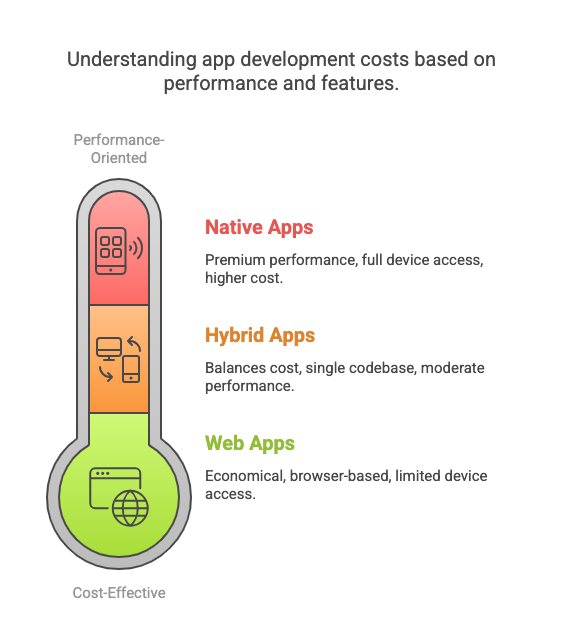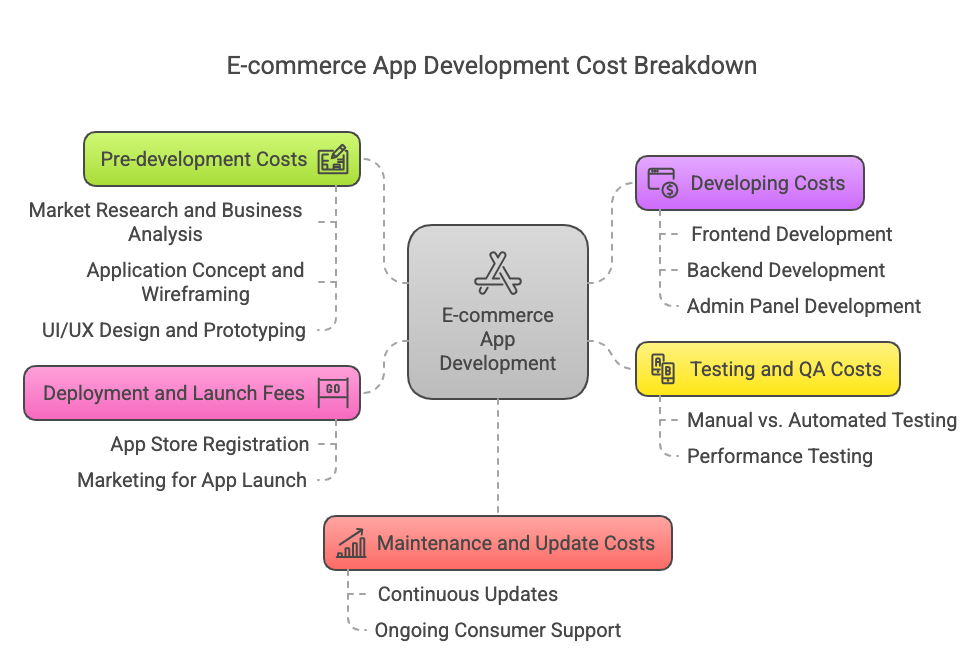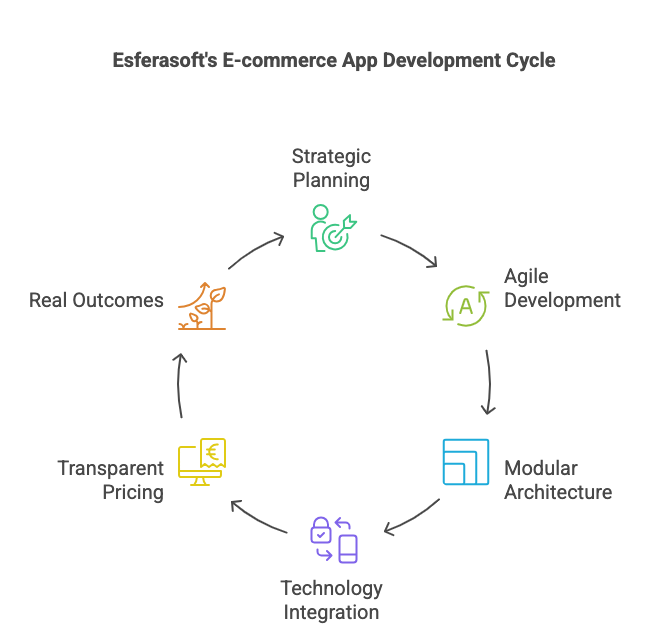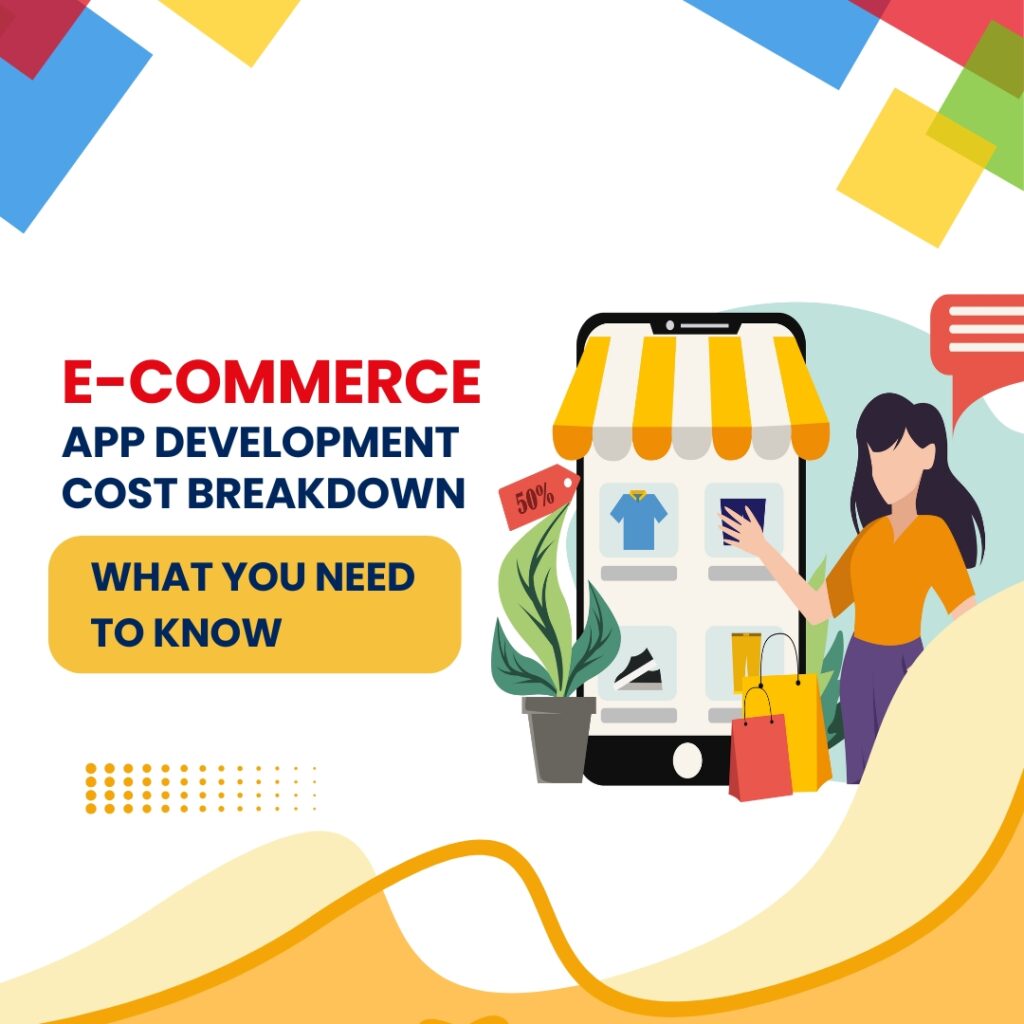|
Getting your Trinity Audio player ready...
|
Being dynamic in e-commerce is no longer an optional business strategy; it is a necessity today in a world where online shopping is now commonplace. By 2025, global e-commerce sales are expected to rise by over $7 trillion, with a significant proportion of transactions occurring through mobile apps.
Today, customers expect fast-loading, great-looking, and easy-to-navigate apps that allow them to seamlessly search the product range, pay safely, track orders in real-time, and offer personalized experiences. Failure to meet these minimal expectations risks giving away customers to contenders that offer more.
The construction of an e-commerce app involves profound investment. Whether you are looking to enter the mobile commerce ecosystem or upgrade your existing app, knowing how to budget effectively will avoid costly mistakes down the road.
This guide will walk you through every considerable cost factor, break down where your money is spent during development, bring up the hidden expenses many businesses don’t consider, and help you make strategic decisions for your project.
Understanding the Key Factors That Influence E-commerce App Development Cost

Starting with the numbers makes little sense unless you consider factors that could drastically and significantly influence your budget. Every decision you make—including the choice of platform and beyond—feeds directly into the total budget.
Platform Choice: Native vs. Hybrid vs. Web Apps
Native Apps (bespoke solutions built separately for iOS and Android) embrace premium performance, user experience, and device integrations, but for their cost—because they are custom-built and require dual development—nothing else comes close.
Hybrid Apps (built on Flutter or React Native) aggregate both platforms under a single codebase for cost-saving but sacrifice optimum performance, especially in complex tasks.
Progressive Web Applications (PWAs) are excellent ways to bring app-like experiences through the browser. They are not an expensive option but might not work well with offline accessibility and device-specific features.
Tip: Begin with a hybrid; invest in native once product-market fit is achieved, provided the budget is less.
App Features & Functionality: Basic vs. Advanced
Every additional feature requires more development time, complex testing, and sometimes specialized expertise.
Basic functionality includes user registration, product listings, shopping carts, and simple checkouts.
Advanced features, such as AI-based product recommendations, voice searches, augmented reality previews, subscriptions, and loyalty programs, greatly increase expenses.
UI/UX Design: Custom Design vs. Template-Based
Creating a seamless shopping experience is not just about how things look on a surface level. It is about how well the layouts flow, how fast they work, and how engaged users are.
Custom UI/UX creates a remarkable brand experience. However, it takes extensive research, prototyping, testing, and polishing. On the other hand, templates are faster and cheaper but limit the style of creativity and scalability you want.
- Investing in user experience leads to conversions.
- Tech Stack: Frontend and Backend Technologies
- The core strength of your app relies on its architecture:
- Frontend: React Native, Flutter, or iOS: Swift.
Backend: Node.js or Django or Laravel with cloud platforms AWS, Azure, or Google Cloud.
Opting for a highly robust technology stack may mean higher acquisition costs but can earn back thousands of maintenance dollars in the future while scaling the application.
Integration Needs
- E-commerce apps don’t exist in isolation; they connect with
- Payment gateways (Stripe, Razorpay, PayPal)
- Inventory management systems
- CRM and ERP platforms
- Shipping service APIs
However, each integration can have its unique complexity and cost.
Scalability & Security
Shortsightedness is building for the current user base. What if your app becomes successful and experiences a 5x surge in users? Would it become vulnerable to various cyber threats?
It can add as much as 20%-30% to your initial costs, but ensuring scalability and security can save you a world of trouble later, not to mention protect your brand.
Cost Breakdown of E-commerce App Development

Now, let’s dissect where your budget typically goes.
Pre-development Costs
Market Research and Business Analysis
Not doing research is like sailing a ship without a map. Good research aligns your application features with actual needs from potential clients and the marketplace. The average cost will be between $3,000 and $3,000–$12,000.
Application Concept and Wireframing
Translating your ideas into concrete wireframes ensures smoother development. The costs will be about $1,500-$5,000 depending on complexity and iterations.
UI/UX Design and Prototyping, plus Feedback
Good design is iterative. High-fidelity prototypes and user testing can add $5,000 to $20,000 to your pre-development budget, but you can use them substantially to build a better user interface.
Developing Costs
Frontend Development
The product page, the checkout flow, and the push notifications received after the purchase are all covered. The expenditure for development ranges from $15,000 to $60,000.
Backend Development
The backend plays a significant role within the application. The backend securely handles logins, payments, inventory, and user data. Depending on scaling requirements, a strong backend can cost between $20,000 and $80,000.
Admin Panel Development
A customised admin dashboard for managing orders, inventory, promotions, and analytics will be in the range of $7000 to $20000, but it will save innumerable operational hours later.
Testing and QA Costs
Manual vs. Automated Testing
Automated scripts catch bugs much quicker, but manual testing ensures that the application works well and intuitively navigates from page to page. Expect to allocate around 20–25% of total development to QA.
Performance Testing, Bug Fixing, and Quality Assurance
The application should be robust enough to handle flash sales and Black Friday traffic. Put aside an extra $5,000 or $15,000 for this.
Deployment and Launch Fees
App Store Registration, Submission Fees, and Hosting Costs
These are small one-time costs for app store submissions ($25 More for Google Play; $99 yearly for Apple). Infrastructure hosting for cloud apps will range between $50 and $500 per month.
Marketing for App Launch (ASO)
Do not build—promote! Launch campaigns, influencer partnerships, paid advertising, and ASO optimization can cost anywhere from $10,000 to $50,000 or more, depending on your market.
Maintenance and Update Costs Continuous Updates, Bug Fixes, and Releases of New Features
It will continue needing feature updates and development after the initial launch to remain competitive. Allocate approximately 15–25% of initial development each year. Ongoing Consumer Support, Security Patches
Real-time customer support (chatbots, live agents) and continuous security updates are crucial for retention and legal compliance.
Essential Features that Impact E-commerce App Costs
Developing an app without these essentials could lead to customer frustration and result in lost revenue.
- Product Catalogue & Smart Search: Investing in AI-powered search engines increases sales but also bumps up development costs.
- Shopping Cart & Checkout Process: One-click checkout boosts conversions but requires careful design and testing.
- Payment Integration: More payment methods (credit, debit, digital wallets, BNPL) = higher integration and security costs.
- Push notifications and real-time updates: Personalised engagement boosts retention but requires backend event handling and analytics.
- User Account Management: Smooth account setup and management increase lifetime value (LTV).
- Security Features: SSL, fraud detection, biometric authentication—skimping on security is not an option.
- Multi-language and multi-currency: Localisation drives global growth but requires significant development, especially around tax and regulatory compliance.
Hidden Costs in E-commerce App Development
Even experienced businesses sometimes forget to account for these:
Third-Party Services
External CRMs, payment processors, and shipping APIs — many charge ongoing fees.
Server & Hosting Costs
Depending on your traffic, cloud services like AWS could add up to thousands annually.
User Acquisition and Retention Costs
Ongoing digital marketing, loyalty, and customer retention campaigns require dedicated budgets.
Data Analytics
Advanced user behavior tracking through Mixpanel, Amplitude, or Firebase might cost hundreds or thousands a year.
Compliance Costs
GDPR fines are hefty. Ensuring proper data privacy policies and compliance documentation is non-negotiable.
Cost Comparison of E-commerce App Development Approaches
Choosing the right approach is critical to project success and budget control.
Custom Development vs. Pre-built Solutions
- Custom Development: Costs more upfront ($70,000–$300,000) but allows for full scalability, branding, and competitive differentiation.
- Pre-built Platforms: Faster and cheaper ($10,000–$50,000) but often restrict customization and future scaling options.
White-label Solutions
This approach is suitable for MVPs or small businesses seeking rapid market entry. Costs are lower, but you sacrifice branding uniqueness and long-term control.
Outsourcing Development vs. In-house Team
- Outsourcing: Cost-effective, global talent access, and flexible scaling.
- In-house: Better long-term alignment but high fixed salaries, benefits, and overheads.
Smart Tip: Start with outsourcing for MVP development, then gradually build an in-house team as you scale.
Esferasoft’s Approach to Cost-Effective E-commerce App Development

We do know at Esferasoft that an e-commerce application does not stop at writing codes. Rather, it is creating experiences that help in growth, loyalty, and profits. Hence our whole approach is based on simple principles-
Strategic Planning
Understanding your goals, audience, and market challenges comes first before letting a single line of code be written. Every single feature we build has a clear purpose—no extras to increase costs without adding value.
Agile Development Methodology
More agile sprints with continuous feedback allow rapid intelligence responses, optimized development times, and the fastest delivery of functional builds. Such practices would make your launch earlier, test real user behavior, and iterate smarter.
Modular & Scalable Architecture
Your application is structured to launch first with core features on an essential basis and be expandable without extensive reworks down the line. This approach thus protects your budget while still supporting your long-term growth.
Technology for Growing with You
We harness tried-and-tested, scalable technologies that keep your app fast and secure and prepare for future demands. By minimizing your technical debt at the start, you can avoid costly building projects in the future.
Transparent, Predictable Pricing
No hidden fees, and no surprise charges. From proposal to delivery, we provide absolute clarity in costs.
Real Outcomes
Finding such a fast-growing fashion startup strapped for funds, we came up with a modular e-commerce application that allowed for organic growth. Eight months after launch, it boasted more than 50,000 active users — all this under the previous budget framework.
Final Thoughts
Strategic Planning: Building for the Long Haul Building an e-commerce application is what defines a technical task; rather, it is a business strategic decision that has a consequence on customer loyalty, brand reputation, and revenue growth. Avoiding common pitfalls to maximize returns requires a deliberate choice of platforms, a flexible technology stack, essential features, and consideration of hidden costs. Choosing the right development partner is equally critical. That will make your investment an entry into app development but not for creating an advantage.
Ready to turn your e-commerce vision into a high-performing reality? Book a free consultation today.

